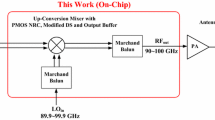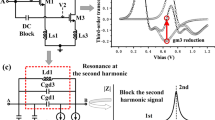Abstract
A simple Cascaded double balanced mixer working at 2.4 GHz, for WLAN application was designed and using 90 nm CMOS technology. The proposed mixer incorprates minimum number of transistors in comparing with the gilbercell mixer. Staking LO stage just above the RF stage reducing the voltage headroom of mixer. Differential combination of RF stage has a common source node and the Differential combination of LO stage has common drain node. Differential combination for both RF and LO stage cancels the feed through error of higher order harmonic signals, improving the linearity of the mixer.Both RF and LO stage contributes to the overall transconductance of the mixer, improving the conversion gain of the mixer. The simulated response of the proposed mixer shows a Conversion gain of 12 dB, IIP3 point of 8.3 dBm and one dB compression point of 8.5 dBm.










Similar content being viewed by others
References
Chen, C., Jianhui, W., Huang, C., & Shi, L. (2013). A CMOS switched load harmonic rejection mixer for DTV tuner applications. IEEE Transactions on Circuits and Systems-I: Regular Papers, 60(2), 428–436.
Ru, Z., Moseley, N. A., Klumperink, E. A. M., & Nauta, B. (2009). Digitally enhanced software-defined radio receiver robust to out-of-band interference. IEEE Journal of Solid-State Circuits, 44(12), 3359–3375.
Oh, N.-J. (2008). A low-noise mixer with an image-reject notch filter for 2.4 GHz applications. Microelectronics Journal, 39, 1860–1866.
Wan, Q., & Wang, C. (2011). A low-voltage low-power CMOS transmitter front-end using current mode approach for 2.4 GHz wireless communications. Microelectronics Journal, 42, 766–771.
Wang, C.-Y., & Tsai, J.-H. (2009). A 51 to 65 GHz low-power bulk-driven mixer using 013 m CMOS technology. IEEE Microwave and Wireless Components Letters, 19(08), 521–523.
Lee, C. J., & Park, C. S. (2016). A D-band gain-boosted current bleeding down-conversion mixer in 65 nm CMOS for chip-to-chip communication. IEEE Microwave and Wireless Components Letters, 26(02), 143–145.
Yo-Sheng Lin and Kai-Siang Lan. (2019). W-band CMOS down-conversion mixer using CMOS-inverter-based RF GM stage for conversion gain and linearity enhancement. Analog Integrated Circuits and Signal Processing, 99, 133–146.
Chen, J.-D., Lin, Z. M., & Row, J. S. (2010). A 5.25-GHz low-power down-conversion mixer in 0.18-lm CMOS technology. Analog Integrated Circuits and Signal Processing, 62, 301–312.
Au-Yeung, C.-F., & Cheng, K.-K. M. (2006). IMD reduction in CMOS double-balanced mixer using multibias dual-gate transistors. IEEE Transaction on Microwave Theory and Techniques, 54(1), 4–9.
Kim, M., Lee, J., & Yun, T. (2012). Low-noise and high-gain mixer combining switched-biasing and current-bleeding techniques. Electronics Letters, 48(23), 1476–1478.
Song Dan and Zhang Xiaolin. (2009). Low-voltage CMOS folded-cascode mixer. Chinese Journal of Aeronautics, 23, 198–203.
Mollaalipour, M. (2015). Second harmonic rejection based on feedback technique in CMOS mixer for multi-band DCR application. Analog Integrated Circuits and Signal Processing, 85, 353–359.
Liang, K.-H., Chang, H.-Y., & Chan, Y.-J. (2007). A 0.5–7.5 GHz ultra low-voltage low-power mixer using bulk-injection method by 0.18-m CMOS technology. IEEE Microwave and Wireless Components Letters, 17(07), 531–533.
Rao, P.-Z., Chang, T.-Y., Liang, C.-P., & Chung, S.-J. (2009). An ultra-wideband high-linearity CMOS mixer with new wideband active baluns. IEEE Transations on Microwave Theory and Techniques, 5(9), 2184–2192.
Subramaniyan, H. K., Klumperink, E. A. M., Srinivasan, V., Kiaei, A., & Nauta, B. (2015). RF transconductor linearization robust to process, voltage and temperature variations. IEEE Journal of Solid-State Circuits, 50(11), 2591–2602.
Ponnambalam, M., Kanaga, M., & Chandramani, P. V. (2017). Improving HRR in 3P–8P harmonic rejection mixer using modified input transconductance stage in hard switching mixer. Analog Integrated Circuits and Signal Processing, 91, 1–7.
Yoon, J., Kim, H., Park, C., Yang, J., Song, H., Lee, S., et al. (2008). A new RF CMOS gilbert mixer with improved noise figure and linearity. IEEE Transactions on Microwave Theory and Techniques, 56(03), 626–631.
Author information
Authors and Affiliations
Corresponding author
Additional information
Publisher's Note
Springer Nature remains neutral with regard to jurisdictional claims in published maps and institutional affiliations.
Rights and permissions
About this article
Cite this article
Ponnambalam, M., Chandramani, P.V. Achieving high linearity and conversion gain in double balanced mixer with cascoded RF and LO stage. Analog Integr Circ Sig Process 107, 65–71 (2021). https://doi.org/10.1007/s10470-020-01759-x
Received:
Revised:
Accepted:
Published:
Issue Date:
DOI: https://doi.org/10.1007/s10470-020-01759-x




